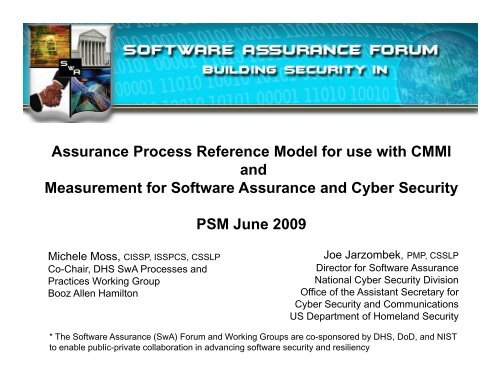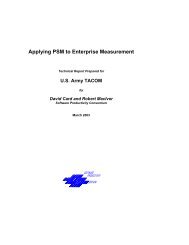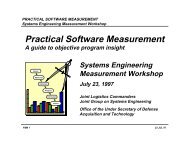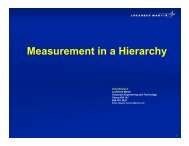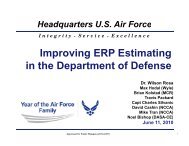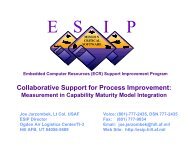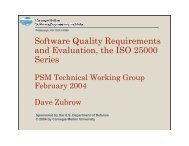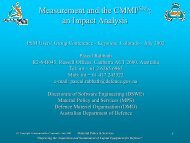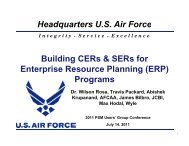Assurance Process Reference Model for use with CMMI - Practical ...
Assurance Process Reference Model for use with CMMI - Practical ...
Assurance Process Reference Model for use with CMMI - Practical ...
You also want an ePaper? Increase the reach of your titles
YUMPU automatically turns print PDFs into web optimized ePapers that Google loves.
<strong>Assurance</strong> <strong>Process</strong> <strong>Reference</strong> <strong>Model</strong> <strong>for</strong> <strong>use</strong> <strong>with</strong> <strong>CMMI</strong><br />
and<br />
Measurement <strong>for</strong> Software <strong>Assurance</strong> and Cyber Security<br />
PSM June 2009<br />
Michele Moss, CISSP, ISSPCS, CSSLP<br />
Co-Chair, Ch DHS SwA <strong>Process</strong>es and<br />
Practices Working Group<br />
Booz Allen Hamilton<br />
Joe Jarzombek, PMP, CSSLP<br />
Director <strong>for</strong> Software <strong>Assurance</strong><br />
National Cyber Security Division<br />
Office of the Assistant Secretary <strong>for</strong><br />
Cyber Security and Communications<br />
US Department of Homeland Security<br />
* The Software <strong>Assurance</strong> (SwA) Forum and Working Groups are co-sponsored by DHS, DoD, and NIST<br />
to enable public-private collaboration in advancing software security and resiliency
Security-Enhanced Capabilities: Mitigating Enterprise Risks<br />
• With today’s global software supply chain, Software/Systems Engineering,<br />
Quality <strong>Assurance</strong>, Testing and Project Management must explicitly address<br />
security risks posed by exploitable software.<br />
– Traditional processes do not explicitly address software-related security risks that can be passed<br />
from projects to using organizations.<br />
– Internationally recognized standards are needed to support processes and provide transparency<br />
<strong>for</strong> more in<strong>for</strong>med decision-making <strong>for</strong> mitigating enterprise risks.<br />
– Many suppliers <strong>use</strong> CMMs to guide process improvement & assess capabilities; yet many CMMs<br />
do not explicitly address safety and security as normative material<br />
– ‘<strong>Assurance</strong>’ needs to be explicitly itl addressed d in standards d & capability benchmarking models <strong>for</strong><br />
organizations involved <strong>with</strong> security/safety-critical applications.<br />
• Mitigating Supply Chain Risks requires an understanding and management of<br />
Suppliers’ Capabilities, Products and Services<br />
– Enterprise risks stemming from supply chain are influenced by suppliers and acquisition iti projects<br />
– IT/Software <strong>Assurance</strong> processes/practices span development/acquisition.<br />
– Derived (non-explicit) security requirements should be elicited/considered.<br />
• More comprehensive security measurement and diagnostic capabilities are<br />
needed to support processes and provide transparency <strong>for</strong> more in<strong>for</strong>med<br />
decision-making <strong>for</strong> mitigating risks to the enterprise<br />
Free resources are available to assist personnel in security-enhancing contracting, outsourcing and development activities<br />
(see https://buildsecurityin.us-cert.gov/swa)
Agenda<br />
• Setting the stage<br />
• A practical example<br />
• Leveraging <strong>Process</strong> Capability Benchmarks<br />
• Summary
*<br />
Acquisition<br />
Program<br />
Supplier<br />
“Supply chain introduces risks to American society<br />
that relies on Federal Government <strong>for</strong> essential<br />
in<strong>for</strong>mation and services.”<br />
30 Sep 2005 changes to Federal Acquisition<br />
iti<br />
Regulation (FAR) focus on IT Security<br />
Foc<strong>use</strong>s on the role of contractors in security as<br />
Federal agencies outsource various IT functions.<br />
“Scope of Supplier Expansion and Foreign Involvement” graphic in DACS www.softwaretechnews.com Secure<br />
Software Engineering, July 2005 article “Software Development Security: A Risk Management Perspective” synopsis<br />
of May 2004 GAO-04-678 report “Defense Acquisition: Knowledge of Software Suppliers Needed to Manage Risks”<br />
4
Enterprise <strong>Process</strong>es <strong>for</strong> deploying capabilities:<br />
Increasingly gyDistributed and Complex<br />
New Considerations <strong>for</strong> Quality & Security<br />
Company<br />
Employees<br />
Contractors<br />
US Dev.<br />
Center A<br />
Open<br />
Source<br />
Agency/<br />
Enterprise<br />
ISV<br />
(COTS)<br />
ISV<br />
Employees<br />
Foreign<br />
Outsource<br />
Contractor<br />
License 3 rd<br />
Party Libraries<br />
Developed<br />
In-ho<strong>use</strong><br />
Purchased<br />
Open<br />
Source<br />
Enterprise<br />
Employees<br />
3 rd Party<br />
Libraries<br />
Outsource<br />
Partner A<br />
Outsourcer<br />
Employees<br />
Foreign<br />
Contractors<br />
Foreign Sub-<br />
Contractors<br />
Offshore<br />
US Dev.<br />
Center B<br />
Source: SwA WG Panel presentations, 2008<br />
Outsource<br />
Partner B<br />
Indian<br />
Contractor<br />
Chinese<br />
Contractor<br />
License 3<br />
Global<br />
rd<br />
Party Libraries
Today’s Reality Requires Increased Confidence In Our IT<br />
Products and Services<br />
• Dependencies on technology are greater then ever<br />
– Rapid advances<br />
– Enhancement of quality of life<br />
– Increased interdependencies<br />
• Possibility of disruption is now greater beca<strong>use</strong> software is vulnerable<br />
– Way of life may be impacted when systems are not available or compromised<br />
– Missions of health, safety, finance, communications, transportation are at risk<br />
• Loss of confidence alone can lead to stakeholder actions that disrupt<br />
critical business activities<br />
Source: Moss Nadworny, “Lessons Learned From Applying An <strong>Assurance</strong> Focus to <strong>CMMI</strong>”, SEPG 2009
What CIOs want<br />
Reliabile software that functions as<br />
promised<br />
Software free from security<br />
vulnerabilities and malicious code<br />
70<br />
95<br />
Ease of Integration & Configuration<br />
55<br />
Software con<strong>for</strong>ms to Requirements<br />
& Industry Standards<br />
Convenience & Ease of Use<br />
27<br />
32<br />
Rich Feature Set<br />
11<br />
Other<br />
0<br />
0 20 40 60 80 100<br />
Percent<br />
https://www.cioexecutivecouncil.com October 11, 2006 Press Release
What Is <strong>Assurance</strong><br />
• <strong>Assurance</strong> – Grounds <strong>for</strong> confidence that an entity meets its<br />
security objectives. [ISO/IEC 15408-1: 2005-10-01].<br />
• Software <strong>Assurance</strong> – The level of confidence that software is free<br />
from vulnerabilities, either intentionally designed into the software or<br />
accidentally inserted at anytime during its life cycle, and the software<br />
functions in the intended manner. [CNSSI 4009]<br />
<strong>Assurance</strong> is a property of software or system that<br />
makes us more com<strong>for</strong>table <strong>with</strong> relying on that system.<br />
Source Bartol, Jarzombek, Moss, “Mitigating Risks to the Enterprise through Development and Acquisition”, SEPG 2009
Software <strong>Assurance</strong> Forum & Working Groups*<br />
… encourage the production, evaluation and acquisition of better<br />
quality and more secure software through targeting<br />
People<br />
Developers and <strong>use</strong>rs<br />
education & training<br />
<strong>Process</strong>es<br />
Sound practices,<br />
standards, & practical<br />
guidelines <strong>for</strong> secure<br />
software development<br />
Build Security In - https://buildsecurityin.us-cert.gov<br />
and SwA community resources & info clearingho<strong>use</strong><br />
SwA Common Body of Knowledge (CBK) & Glossary<br />
Organization of SwSys Security Principles/Guidelines<br />
SwA Developers' Guide on Security-Enhancing SDLC<br />
Software Security <strong>Assurance</strong> State of the Art Report<br />
Systems <strong>Assurance</strong> Guide (via DoD and NDIA)<br />
SwA-related standards – ISO/IEC JTC1 SC7/27/22,<br />
IEEE CS, OMG, TOG, & CMM-based <strong>Assurance</strong><br />
Technology<br />
Security test criteria,<br />
diagnostic tools,<br />
common enumerations,<br />
SwA R&D, and SwA<br />
measurement<br />
Products and Contributions<br />
Acquisition<br />
Software security<br />
improvements through<br />
due-diligence questions,<br />
specs and guidelines <strong>for</strong><br />
acquisitions/ outsourcing<br />
<strong>Practical</strong> Measurement Framework <strong>for</strong> SwA/InfoSec<br />
Making the Business Case <strong>for</strong> Software <strong>Assurance</strong><br />
SwA Metrics & Tool Evaluation (<strong>with</strong> NIST)<br />
SwA Ecosystem w/ DoD, NSA, NIST, OMG & TOG<br />
NIST Special Pub 500 Series on SwA Tools<br />
Common Weakness Enumeration (CWE) dictionary<br />
Common Attack Pattern Enumeration (CAPEC)<br />
SwA in Acquisition: Mitigating Risks to Enterprise<br />
Software Project Management <strong>for</strong> SwA SOAR<br />
* SwA Forum is part of Cross-Sector Cyber Security Working Group (CSCSWG) established<br />
under auspices of the Critical Infrastructure Partnership Advisory Council (CIPAC) that<br />
9<br />
provides legal framework <strong>for</strong> participation.
SwA Concerns of Int’l Standards Organizations<br />
TMB<br />
Risk Mgmt<br />
Vocabulary<br />
ISO<br />
Advisory<br />
Group on<br />
Security<br />
IEC<br />
JTC1<br />
TC176 TC56 TC65<br />
In<strong>for</strong>mation<br />
Technology<br />
Quality Mgmt Dependability Safety<br />
SC7<br />
SC27<br />
SC22<br />
SW & System<br />
Engineering<br />
IT Security<br />
Programming<br />
Languages<br />
* DHS NCSD has membership on SC7, SC27 & IEEE S2ESC<br />
leveraging Liaisons in place or requested <strong>with</strong> other committees<br />
10
The <strong>Assurance</strong> Problem Space<br />
Large-scale systems and systems of systems represent a complex<br />
supply chain integrating<br />
– Proprietary and open-source software<br />
– Legacy systems<br />
– Hardware and Firmware<br />
These systems are sourced from multiple suppliers who employ<br />
people from around the world<br />
Most systems depend upon software <strong>for</strong> their functionality<br />
Technologies to build reliable and secure software are inadequate<br />
– Our ability to develop software has not kept pace <strong>with</strong> hardware<br />
advances<br />
– Can’t construct complex software-intensive systems <strong>for</strong> which we can<br />
anticipate per<strong>for</strong>mance<br />
<strong>Assurance</strong> is a full life cycle problem<br />
11
DoD-Related Guidance For Systems<br />
<strong>Assurance</strong><br />
National Defense Industrial Association Guidebook on<br />
Engineering <strong>for</strong> System <strong>Assurance</strong><br />
– Correspondence <strong>with</strong> Existing Documentation, Policies, and Standards<br />
Executive Policy, Services Standards, NIST/NSA (NIAP) Standards, GEIA,<br />
AIA, IEEE, ISO/IEC Standards, Best Practice (e.g., DHS/DOD SwA CBK)<br />
– Intended to supplement the knowledge of systems (and software)<br />
engineers who have responsibility <strong>for</strong> systems <strong>for</strong> which there are<br />
assurance concerns<br />
General Guidance mapped to ISO/IEC 15288, System Life Cycle <strong>Process</strong>es<br />
DoD Specific Guidance<br />
– Anti-Tamper<br />
– DAG Lifecycle Framework<br />
– Technology ogy Development e e Phase<br />
– System Development & Demonstration Phase<br />
– Production, Deployment, Operations, & Support Phases<br />
– Supporting <strong>Process</strong>es<br />
– Periodic Reports<br />
– Supplier <strong>Assurance</strong><br />
– Mappings<br />
12
NDIA/DoD System <strong>Assurance</strong> Guidebook –<br />
Mapped To ISO/IEC/IEEE 15288<br />
pp<br />
Agreement <strong>Process</strong>es<br />
– Acquisition<br />
– Supply<br />
Project <strong>Process</strong>es<br />
– Project Planning<br />
– Project Assessment<br />
– Project Control<br />
– Decision-making<br />
– Risk Management<br />
– Configuration Management<br />
– In<strong>for</strong>mation Management<br />
<strong>Assurance</strong> Case <strong>Process</strong><br />
Technical <strong>Process</strong>es<br />
– Stakeholder Requirements<br />
Definition<br />
– Requirements Analysis<br />
– Architectural Design<br />
– Implementation<br />
– Integration<br />
– Verification<br />
– Transition<br />
– Validation<br />
– Operation<br />
– Maintenance<br />
– Disposal<br />
Enterprise <strong>Process</strong>es<br />
– Enterprise Environment<br />
– System Life Cycle <strong>Process</strong><br />
Management<br />
Management<br />
– Investment t Management – Resource Management [including<br />
human resource training]<br />
– Quality Management<br />
13
ISO/IEC JTC1 SC7 Software and Systems<br />
Engineering:<br />
ISO/IEC 15026 “Systems and Software <strong>Assurance</strong>”<br />
ISO/IEC24748: Guide to Life Cycle Management<br />
Other<br />
standards<br />
d<br />
providing<br />
details of<br />
selected SW<br />
processes<br />
Source: J. Moore, SC7<br />
Liaison Report, IEEE<br />
Software and Systems<br />
Engineering i Standards<br />
d<br />
Committee, Executive<br />
Committee Winter<br />
Plenary Meeting,<br />
February 2007.<br />
ISO/IEC12207:<br />
Life cycle<br />
processes <strong>for</strong><br />
Software<br />
ISO/IEC<br />
15289:<br />
Document -<br />
ation<br />
Interoperation<br />
ISO/IEC<br />
16326:<br />
Project<br />
Mgmt<br />
ISO/IEC15288:<br />
Other<br />
Life cycle<br />
standards<br />
d<br />
processes <strong>for</strong><br />
providing<br />
systems<br />
details of<br />
selected<br />
system<br />
processes<br />
ISO/IEC<br />
+<br />
15939:<br />
Measure -<br />
ment<br />
ISO/IEC<br />
16085:<br />
Risk<br />
Mgmt<br />
ISO/IEC15026:<br />
Additional<br />
practices <strong>for</strong><br />
higher<br />
assurance<br />
systems<br />
Common vocabulary, process architecture, and process description<br />
conventions<br />
“System and software assurance foc<strong>use</strong>s on the management of risk and assurance of<br />
safety, security, and dependability <strong>with</strong>in the context of system and software life cycles.”<br />
Terms of <strong>Reference</strong> changed: ISO/IEC JTC1/SC7 WG7, previously “System and Software Integrity” SC7 WG9<br />
14
ISO/IEC/IEEE 15026, System and Software<br />
<strong>Assurance</strong><br />
A four-part standard<br />
– 15026-1: 1 Concepts and vocabulary<br />
Initially a Technical Report<br />
– 15026-2: <strong>Assurance</strong> case<br />
Includes requirements on the assurance case content<br />
and the life cycle of the assurance case itself as well<br />
as an in<strong>for</strong>mative cla<strong>use</strong> on planning <strong>for</strong> the<br />
assurance case itself<br />
– 15026-3: System integrity it levels l (a revision i of the<br />
1998 standard)<br />
Relates integrity levels to the assurance case and<br />
includes related requirements <strong>for</strong> their <strong>use</strong> <strong>with</strong> and<br />
<strong>with</strong>out an assurance case<br />
– 15026-4: <strong>Assurance</strong> in the life cycle<br />
Addresses concurrent development and maintenance<br />
of the product and the assurance case including<br />
project planning <strong>for</strong> assurance considerations<br />
15
ISO/IEC/IEEE 15026 <strong>Assurance</strong> Case<br />
Set of structured assurance claims,<br />
supported by evidence and reasoning<br />
(arguments), that demonstrates how<br />
assurance needs have been satisfied.<br />
– Shows compliance <strong>with</strong> assurance<br />
objectives<br />
– Provides an argument <strong>for</strong> the safety<br />
and security of the product or service.<br />
– Built, collected, and maintained<br />
throughout the life cycle<br />
– Derived from multiple sources<br />
System, Software, or Work Product<br />
Sub-parts<br />
– A high level summary<br />
– Justification that product or service is<br />
acceptably safe, secure, or<br />
dependable<br />
– Rationale <strong>for</strong> claiming a specified<br />
level of safety and security<br />
– Con<strong>for</strong>mance <strong>with</strong> relevant standards<br />
& regulatory requirements<br />
– The configuration baseline<br />
– Identified hazards and threats and<br />
residual risk of each hazard / threat<br />
– Operational & support assumptions<br />
Make the case <strong>for</strong> adequate quality/ assurance of the<br />
justify belief in<br />
Quality / <strong>Assurance</strong><br />
Factor<br />
Claims<br />
Arguments<br />
Evidence<br />
is developed <strong>for</strong><br />
Quality / <strong>Assurance</strong> Case<br />
supports<br />
Quality / <strong>Assurance</strong><br />
Subfactor<br />
<br />
<br />
<br />
<br />
<br />
<br />
<br />
Attributes<br />
Clear<br />
Consistent<br />
Complete<br />
Comprehensible<br />
Defensible<br />
Bounded<br />
Addresses all<br />
life cycle stages<br />
16
SwA Measurement<br />
Drivers<br />
• Need to demonstrate the value of SwA<br />
• Decreasing funding and increasing<br />
accountability <strong>for</strong> it<br />
• Calls <strong>for</strong> quantifiable ROI and risk<br />
exposure<br />
• Need <strong>for</strong> data to support decisions and<br />
substantiate assurance claims<br />
Benefits<br />
• Supports business case <strong>for</strong> assurance<br />
• Provides quantifiable in<strong>for</strong>mation to support<br />
decision making and accountability<br />
• Quantifies SwA improvements<br />
• Helps demonstrate regulatory compliance<br />
• Helps demonstrate value to executives<br />
• Motivates stakeholder to change behavior<br />
Response<br />
• Developed <strong>Practical</strong> measurement Framework <strong>for</strong> Software <strong>Assurance</strong> and In<strong>for</strong>mation Security<br />
• Is harmonized <strong>with</strong> common system and software and security measurement methodologies<br />
• Provides an approach <strong>for</strong> quantifying achievement of SwA goals and objectives <strong>with</strong>in the<br />
context of individual projects, programs, or enterprises<br />
• Provides a framework <strong>for</strong> the organizations to integrate SwA measurement in their overall<br />
measurement ef<strong>for</strong>ts in a cost-effective and a seamless manner<br />
• http://www.psmsc.com/Downloads/TechnologyPapers/SwA%20Measurement%2010-08-8.pdf
Base Methodologies<br />
• ISO/IEC 15939, <strong>Practical</strong> Software and System Measurement (PSM)<br />
• <strong>CMMI</strong> Measurement and Analysis <strong>Process</strong> Area<br />
• <strong>CMMI</strong> Goal, Question, Indicator, Measure (GQIM)<br />
• NIST SP 800-55 Rev1, Per<strong>for</strong>mance Measurement Guide <strong>for</strong><br />
In<strong>for</strong>mation Security<br />
• ISO/IEC 27004, In<strong>for</strong>mation Security Management Measurement<br />
Existing measurement methodologies can be applied to SwA and supply chain
Measurement Framework<br />
PSM<br />
<strong>CMMI</strong>®<br />
<strong>CMMI</strong>®<br />
ISO/IEC<br />
NIST SP<br />
ISO/IEC 15939 (Measurement<br />
and Analysis<br />
<strong>Process</strong> Area)<br />
GQ(I)M 27004 800-55<br />
Revision 1
Base Methodologies<br />
• ISO/IEC 15939, <strong>Practical</strong> Software and System Measurement (PSM)<br />
• <strong>CMMI</strong> Measurement and Analysis <strong>Process</strong> Area<br />
• <strong>CMMI</strong> Goal, Question, Indicator, Measure (GQIM)<br />
• NIST SP 800-55 Rev1, Per<strong>for</strong>mance Measurement Guide <strong>for</strong><br />
In<strong>for</strong>mation Security<br />
• ISO/IEC 27004, In<strong>for</strong>mation Security Management Measurement<br />
-----------------------------------------------<br />
• <strong>Practical</strong> Measurement Framework <strong>for</strong> Software <strong>Assurance</strong> and<br />
In<strong>for</strong>mation Security<br />
• CIS Security Metrics<br />
• Measuring Cyber Security and In<strong>for</strong>mation <strong>Assurance</strong><br />
Existing measurement methodologies can be applied to SwA and supply chain
Security Measurement Resources<br />
<strong>Practical</strong> Measurement<br />
Framework <strong>for</strong><br />
Software <strong>Assurance</strong><br />
and<br />
In<strong>for</strong>mation Security<br />
Oct 2008
Stakeholders<br />
Organizations<br />
People<br />
Supplier<br />
Executive<br />
Acquirer<br />
Practitioner
Measurement <strong>Process</strong><br />
Create/<br />
Update<br />
Measures<br />
Collect<br />
Data<br />
Store<br />
Data<br />
Analyze and<br />
Compile<br />
Data<br />
Report<br />
Measures<br />
Use<br />
Measures<br />
• State goals<br />
• Identify data<br />
sources and<br />
elements<br />
• Analyze how<br />
goals and data<br />
elements relate<br />
• Create a series<br />
of measures<br />
• Gather data<br />
from available<br />
data sources<br />
• Document/<br />
store data in<br />
an appropriate<br />
repository<br />
• Analyze<br />
collected data<br />
• Compile and<br />
aggregate into<br />
measures<br />
• Interpret data<br />
• Identify<br />
ca<strong>use</strong>s of<br />
findings<br />
• Document<br />
measures in<br />
appropriate<br />
reporting<br />
<strong>for</strong>mats<br />
• Report<br />
measures to<br />
stakeholders<br />
• Support decisions<br />
• Allocate resources<br />
• Prioritize<br />
improvements<br />
• Communicate to<br />
executives and<br />
external<br />
stakeholders<br />
Continuous Improvement<br />
• Refresh measures to ensure they are still relevant to the project,<br />
program, or organization<br />
• Train measurement staff
Security Control Measures<br />
• Percent of new systems that have completed certification and<br />
accreditation (C&A) prior to their implementation (NIST SP 800-53<br />
Control: CA-6: Security Accreditation)<br />
• Percent of employees who are authorized access to in<strong>for</strong>mation<br />
systems only after they sign an acknowledgement that they have<br />
read and understood rules of behavior (NIST SP 800-53 Controls –<br />
PL-4: Rules of Behavior and AC-2: Account Management)<br />
• Percent of the agency’s in<strong>for</strong>mation system budget devoted to<br />
in<strong>for</strong>mation security (NIST SP 800-53 Controls – SA-2; Allocation of<br />
Resources)<br />
S it C t l M dd li ith th d t t f th<br />
Security Control Measures address compliance <strong>with</strong> the end state of the<br />
system, but not the underlying processes, structures, and code
SwA Measures<br />
• Acquisition<br />
– Number and percent of acquisition discussions that include SwA representative<br />
– Number and percent of contracting officers who received training in the security<br />
provisions i of the FAR<br />
– Percent of documented Supplier claims verified through testing, inspection, or other<br />
methods<br />
– Number and percent of relevant high impact vulnerabilities (CVEs) present in the<br />
system<br />
• Testing<br />
– Number and percent of tests that evaluate application response to mis<strong>use</strong>, ab<strong>use</strong>, or<br />
threats t<br />
– Number and percent of tests that attempt to subvert execution or work around security<br />
controls<br />
– Percent of untested source code related to security controls and SwA requirements<br />
SwA Measures address transparency of processes and product properties
The Relationship between Quality and <strong>Assurance</strong><br />
Requirements<br />
What is wanted<br />
What is created<br />
Unmet<br />
requirements<br />
Extra<br />
Requirements<br />
Quality - Does the<br />
result meet the<br />
requirements?<br />
It isn’t about Quality OR <strong>Assurance</strong> …<br />
It is about Quality AND <strong>Assurance</strong><br />
<strong>Assurance</strong> -<br />
• What other features are<br />
enabled?<br />
• How do these other<br />
features impact the<br />
original requirements?<br />
Source: Moss Nadworny, “Lessons Learned From Applying An <strong>Assurance</strong> Focus to <strong>CMMI</strong>”, SEPG 2009
makingsecuritymeasurable.mitre.org
SwA Measurement Working Group<br />
Trend of CVEs <strong>with</strong> high CVSS<br />
scores against maturity levels<br />
indicates a relationship<br />
between maturity level and<br />
CVSS scores<br />
EAL<br />
Rating<br />
Number of or<br />
CWEs per set<br />
number of lines<br />
of code<br />
CVEs present on<br />
the system <strong>with</strong><br />
CVSS score<br />
above 7<br />
Interpretation<br />
In<strong>for</strong>mation<br />
Product<br />
Derived<br />
Measure<br />
Measurement<br />
Function<br />
Indicator<br />
Analysis<br />
<strong>Model</strong><br />
Derived<br />
Measure<br />
Estimate or Evaluation that<br />
Provides a Basis <strong>for</strong> Decision -<br />
Making<br />
Algorithm Combining Measures and<br />
Decision Criteria<br />
In<strong>for</strong>mation Needs<br />
Quantity Defined as a Function of<br />
Two or More Measures<br />
Algorithm Combining Two or More<br />
Base Measures<br />
CVSS Score<br />
Understand the impact of<br />
improved assurance<br />
practices<br />
Comparison of CVEs <strong>with</strong><br />
CVSS scores above 7<br />
compared <strong>with</strong> project’s<br />
Maturity Level<br />
<strong>CMMI</strong><br />
Maturity<br />
Level<br />
Measurement<br />
<strong>Process</strong><br />
Base<br />
Measure<br />
Base<br />
Measure<br />
A Measure of a Single Attribute<br />
By a Specific Method<br />
Number of<br />
lines of code<br />
Number of<br />
CVEs or<br />
CWEs<br />
Measurement<br />
Line of code<br />
Measurement<br />
Method<br />
Attribute<br />
Measurement<br />
Method<br />
Attribute<br />
Adapted from ISO/IEC 15939 - Software Measurement <strong>Process</strong><br />
Operations Quantifying an<br />
Attribute Against a Scale<br />
Property Relevant to<br />
In<strong>for</strong>mation Needs<br />
Entities<br />
MOF<br />
Element<br />
CVE/CWE/defect<br />
Measured<br />
Artifact
Agenda<br />
• Setting the stage<br />
• A practical example<br />
• Leveraging <strong>Process</strong> Capability Benchmarks<br />
• Conclusion
<strong>Practical</strong> Example – Sample Code<br />
#include <br />
#define BUFSIZE 100<br />
void foo(char *bar) {<br />
char BUF[BUFSIZE];<br />
strcpy(BUF, bar);<br />
printf("%s\n", BUF);<br />
}<br />
int main() {<br />
char *baz;<br />
baz = getenv("HOME");<br />
foo(baz);<br />
exit(0);<br />
}<br />
1. Allocate a buffer<br />
2. Copy bar into BUF<br />
3. Print BUF<br />
4. Retrieve pointer<br />
to HOME<br />
5. Print out HOME<br />
April 1999, Evan Thomas, CS student, University of British Columbia<br />
http://www.cosc.brocku.ca/~cspress/HelloWorld/1999/04-apr/attack_class.html<br />
Source: Moss Nadworny, “Lessons Learned From Applying An <strong>Assurance</strong> Focus to <strong>CMMI</strong>”, SEPG 2009
<strong>Practical</strong> Example - Validation<br />
#include <br />
#define BUFSIZE 100<br />
void foo(char *bar) {<br />
char BUF[BUFSIZE];<br />
strcpy(BUF, bar);<br />
printf("%s\n", " BUF);<br />
}<br />
int main() {<br />
char *baz;<br />
baz = getenv("HOME");<br />
foo(baz);<br />
exit(0);<br />
}<br />
What happens if contents of bar<br />
pointer >= 100?<br />
April 1999, Evan Thomas, CS student, University of British Columbia<br />
http://www.cosc.brocku.ca/~cspress/HelloWorld/1999/04-apr/attack_class.html<br />
Source: Moss Nadworny, “Lessons Learned From Applying An <strong>Assurance</strong> Focus to <strong>CMMI</strong>”, SEPG 2009
<strong>Practical</strong> Example - Defect Identified!<br />
System crash is the good news!<br />
=> >You know you have a problem<br />
If the system doesn’t crash, how<br />
does this situation manifest itself?<br />
=> Non reproducible error that is very<br />
difficult/costly to debug<br />
April 1999, Evan Thomas, CS student, University of British Columbia<br />
http://www.cosc.brocku.ca/~cspress/HelloWorld/1999/04-apr/attack_class.html<br />
Source: Moss Nadworny, “Lessons Learned From Applying An <strong>Assurance</strong> Focus to <strong>CMMI</strong>”, SEPG 2009
<strong>Practical</strong> Example - <strong>Assurance</strong> Exploit<br />
• Start out <strong>with</strong> “excessive” input values<br />
– Increase until a system crash<br />
– Denial of Service Attack<br />
– Back off until the system does not crash<br />
– Insert new return values and new code<br />
– Take over the application or service<br />
• Leave little evidence you have taken over the application or what<br />
damage has been ca<strong>use</strong>d<br />
Source: Moss Nadworny, “Lessons Learned From Applying An <strong>Assurance</strong> Focus to <strong>CMMI</strong>”, SEPG 2009
Agenda<br />
• Setting the stage<br />
• A practical example<br />
• Leveraging <strong>Process</strong> Capability Benchmarks<br />
• Summary
Integrate And Improve <strong>Assurance</strong> Practices In The SDLC<br />
Governance Framework<br />
Policy<br />
<strong>Process</strong> Capability Feedback<br />
and Improvement<br />
Project leadership and team members need to<br />
know where and how to contribute<br />
<strong>Process</strong>es<br />
<strong>for</strong> <strong>Assurance</strong><br />
Methodologies<br />
Detailed Criteria<br />
Focus Topic: <strong>Assurance</strong> <strong>for</strong> <strong>CMMI</strong> ® defines<br />
the <strong>Assurance</strong> Thread <strong>for</strong> Implementation and<br />
Improvement of <strong>Assurance</strong> Practices<br />
(The “what” not the “how”)<br />
https://buildsecurityin.us-cert.gov/swa/procresrc.html<br />
SM SCAMPI is a service mark of Carnegie Mellon University.
<strong>Assurance</strong> in Maturity <strong>Model</strong>s<br />
Many suppliers <strong>use</strong><br />
CMMs to guide<br />
process improvement<br />
& assess capabilities;<br />
yet many CMMs do<br />
not explicitly address<br />
safety and security.<br />
Policy<br />
Project leadership and team members<br />
need to know where and how to contribute<br />
<strong>Process</strong>es<br />
<strong>for</strong> <strong>Assurance</strong> Focus Topic: <strong>Assurance</strong> <strong>for</strong> Capability<br />
Maturity <strong>Model</strong> Integration (<strong>CMMI</strong>) ®<br />
defines the <strong>Assurance</strong> Thread <strong>for</strong><br />
Methodologies<br />
Implementation and Improvement of<br />
For achieving <strong>Assurance</strong><br />
<strong>Assurance</strong> Practices<br />
Detailed Criteria<br />
® Capability Maturity <strong>Model</strong>, Capability<br />
Maturity <strong>Model</strong>ing, and CMM are registered in<br />
the U.S. Patent & Trademark Office.<br />
https://buildsecurityin.us-cert.gov/swa/procresrc.html<br />
ty us ce t /s oc es c t<br />
Experience gained <strong>for</strong> “<strong>Assurance</strong>” enhanced processes in U.S. DoD and FAA joint project on Safety and Security Extensions<br />
<strong>for</strong> Integrated Capability Maturity <strong>Model</strong>s, September 2004, at SwA Community Resources and In<strong>for</strong>mation Clearingho<strong>use</strong> - see<br />
https://buildsecurityin.us-cert.gov/swa/downloads/SafetyandSecurityExt-Sep2004.pdf<br />
Other <strong>Assurance</strong> Maturity <strong>Model</strong>s have been released in 2009:<br />
The Building Security In Maturity <strong>Model</strong> (BSIMM) helps organizations plan software security initiatives http://www.bsi-mm.com/<br />
The Software <strong>Assurance</strong> Maturity <strong>Model</strong> (SAMM) which is an open framework to help organizations <strong>for</strong>mulate and implement a<br />
strategy <strong>for</strong> software security that is tailored to specific risks facing the organization http://www.opensamm.org/
<strong>Process</strong> <strong>Reference</strong> <strong>Model</strong> - Overview<br />
<strong>Assurance</strong> <strong>Process</strong> Management<br />
• Achieve key business objectives<br />
• Establish an environment to sustain<br />
assurance<br />
• Deploy assurance capabilities and<br />
features across the organization that<br />
achieve the business assurance goals.<br />
<strong>Assurance</strong> Project Management<br />
• Manage assurance against plans<br />
• Manage assurance support activities<br />
• Select and Manage Suppliers based<br />
upon assurance capabilities<br />
<strong>Assurance</strong> Engineering<br />
• Establish assurance requirements<br />
• Architect a solution <strong>for</strong> assurance<br />
• Verify and validate the product<br />
assurance<br />
• Identify and manage risks due to<br />
existence of vulnerabilities<br />
<strong>Assurance</strong> Support Activities<br />
• Per<strong>for</strong>m product assurance audits<br />
• Determine root ca<strong>use</strong>s of assurance<br />
defects<br />
• Protect project and organizational<br />
assets<br />
• Identify and manage risks due to<br />
existence of vulnerabilities
<strong>CMMI</strong>-DEV v1.2<br />
Supplier<br />
Agreement<br />
Management<br />
SAM is in the Project<br />
Management Category<br />
Requirements<br />
Development<br />
Product<br />
Integration<br />
<strong>CMMI</strong> <strong>Model</strong><br />
Foundation<br />
(CMF)<br />
16 Project<br />
Management,<br />
<strong>Process</strong><br />
Management,<br />
and Support<br />
<strong>Process</strong> Areas<br />
Technical<br />
Solution<br />
Verification<br />
Validation
<strong>Assurance</strong> For <strong>CMMI</strong> Identifies<br />
The <strong>Assurance</strong> Thread <strong>for</strong> <strong>CMMI</strong>-DEV<br />
<strong>Process</strong> Area<br />
Specific<br />
Goals<br />
<strong>Assurance</strong><br />
Focus <strong>for</strong> Goal<br />
Generic<br />
Goals<br />
Specific<br />
Practices<br />
Generic<br />
Practices<br />
<strong>Assurance</strong><br />
Focus <strong>for</strong> practice
<strong>Assurance</strong> Focus For <strong>CMMI</strong> ®<br />
Context of <strong>Assurance</strong> <strong>for</strong> the PA<br />
<strong>Assurance</strong> practice aligned <strong>with</strong><br />
existing <strong>CMMI</strong>® specific practice<br />
Supporting examples, sub<br />
practices, etc that clarify the<br />
<strong>Assurance</strong> practice<br />
Typical Work<br />
Products
Measurement and Analysis Overview and Specific Goal 1<br />
The purpose of Measurement and Analysis (MA) is to develop and sustain a measurement<br />
capability that is <strong>use</strong>d to support management in<strong>for</strong>mation needs.<br />
SG 1 Align Measurement and Analysis Activities<br />
Measurement objectives and activities are aligned <strong>with</strong> identified in<strong>for</strong>mation needs and objectives.<br />
SP 1.1 Establish and maintain measurement objectives that are derived from identified in<strong>for</strong>mation needs<br />
and objectives.<br />
SP 1.2 Specify measures to address the measurement objectives.<br />
In order to support a project’s assurance activities, creation of measures related to the<br />
assurance of a product or service may be required <strong>for</strong> internal and external stakeholders.<br />
SP 1.3 Specify how measurement data will be obtained and stored.<br />
SP 1.4 Specify how measurement data will be analyzed and reported.
<strong>Assurance</strong> Focus <strong>for</strong> MA SP 1.2<br />
MA SP 1.2<br />
AF 1.2.1 Define and improve project assurance measures.<br />
Description<br />
Stakeholder organizations interested in assurance have identified in<strong>for</strong>mation<br />
assurance needs and objectives. Based upon these assurance objectives,<br />
measures are defined to monitor and track the success the project team has in<br />
meeting those objectives. It is expected that the measures collected will evolve over<br />
time from advances in the assurance capabilities as well as changes in<br />
organizational and product assurance objectives. A subset of these measures may<br />
become a <strong>for</strong>mal part of the product or service that provides updates on the<br />
assurance of the product or service over time.<br />
Typical Work Products:<br />
• Specification of base and derived assurance measures<br />
• Updated sets of assurance measures
Measurement and Analysis Specific Goal 2<br />
SG 2 Provide Measurement Results<br />
Measurement results, which address identified in<strong>for</strong>mation needs and objectives, are<br />
provided.<br />
SP 2.1 Obtain specified measurement data.<br />
SP 2.2 Analyze and interpret measurement data.<br />
SP 2.3 Manage and store measurement data, measurement specifications, and analysis<br />
results.<br />
Data related to the assurance of the product contains in<strong>for</strong>mation about<br />
potentially exploitable weaknesses in a product or service. In the <strong>for</strong>m of an<br />
assurance case, this data becomes part of the product or service. Improper<br />
access or <strong>use</strong> of the data may ca<strong>use</strong> potential harm. Proper management and<br />
storage of this in<strong>for</strong>mation is important to maintain the controlled access and<br />
ensure that the in<strong>for</strong>mation is not lost or damaged.<br />
SP 2.4 Report results of measurement and analysis activities to all relevant stakeholders
<strong>Assurance</strong> Focus <strong>for</strong> MA SP 2.3<br />
MA SP 2.3<br />
AF 2.3.1 Store assurance measures appropriately.<br />
Description<br />
Due to the sensitivity of the data, additional care must be given to identify the<br />
appropriate audiences <strong>for</strong> the various assurance measures. For audiences such as<br />
the project team, more detailed views may be desired and needed <strong>for</strong> effective <strong>use</strong><br />
of the data. Conversely, executives or other stakeholders may only need a summary<br />
that can be <strong>use</strong>d <strong>for</strong> justification of assurance practices or decision making based on<br />
a summary view of the data. The assurance data that is part of the assurance case<br />
becomes an important artifact and part of the product or service.<br />
Typical Work Products:<br />
Typical Work Products:<br />
• Stored assurance measurement data inventory.<br />
• <strong>Assurance</strong> data protection mechanisms<br />
• <strong>Assurance</strong> case
Measurable Practices <strong>for</strong> Secure Coding (1 of 3)<br />
SDLC Activity<br />
What<br />
How<br />
<strong>Assurance</strong> <strong>for</strong> <strong>CMMI</strong> SafeCode BSIMM<br />
Code Review<br />
OPDAF111Establish 1.1.1 Fundamental Practices <strong>for</strong><br />
SR Level 1: Provide easily<br />
Checklists and maintain<br />
organizational processes<br />
to achieve the assurance<br />
Secure SW Development<br />
(section on Programming)<br />
accessible security<br />
standards and (compliancedriven)<br />
requirements<br />
business objectives.<br />
TS AF 3.1.2 Identify<br />
deviations from<br />
assurance coding<br />
standards.<br />
Static Analysis<br />
Tools<br />
IPM AF 1.3.1 Establish<br />
and maintain assurance<br />
of the project’s work<br />
environment based on<br />
the organization’s work<br />
environment standards.<br />
Fundamental Practices <strong>for</strong><br />
Secure SW Development<br />
(section on Programming)<br />
CR Level 2: En<strong>for</strong>ce<br />
standards through<br />
mandatory automated code<br />
review and centralized<br />
reporting<br />
CR Level 3: Build an<br />
automated code review<br />
factory <strong>with</strong> tailored rules
Measurable Practices <strong>for</strong> Secure Coding (1 of 3)<br />
SDLC Activity<br />
Train<br />
Developers<br />
Manage Project<br />
Risks<br />
Identify Policy<br />
What<br />
How<br />
<strong>Assurance</strong> <strong>for</strong> <strong>CMMI</strong> SafeCode BSIMM<br />
OT AF 1.1.1 Establish<br />
and maintain the<br />
strategic assurance<br />
training needs of the<br />
organization<br />
“Fundamental Practices <strong>for</strong><br />
Secure SW Development”<br />
(section on Requirements)<br />
“Security Engineering<br />
Training” whitepaper<br />
T Level 1: Create the<br />
software security satellite<br />
T Level 2: Make<br />
customized, role-based<br />
training available on<br />
demand<br />
organization Training whitepaper training available on<br />
PMC AF 1.3.1 Monitor<br />
<strong>Assurance</strong> Risk<br />
OPF AF 1.1.1 Establish<br />
and maintain the<br />
description of the<br />
assurance context and<br />
objectives <strong>for</strong> the<br />
organization.<br />
Not specifically identified<br />
Not specifically identified<br />
SM Level 3: Practice Risk-<br />
Based portfolio<br />
management<br />
[CP1.2] Create Policy
Measurable Practices <strong>for</strong> Secure Coding (1 of 3)<br />
SDLC Activity<br />
Follow a process<br />
What<br />
How<br />
<strong>Assurance</strong> <strong>for</strong> <strong>CMMI</strong> SafeCode BSIMM<br />
OPD AF 1.1.1 Establish<br />
and maintain<br />
organizational processes<br />
to achieve the assurance<br />
business objectives<br />
OPD AF 1.3.1 Establish<br />
and maintain the<br />
tailoring criteria and<br />
guidelines <strong>for</strong> assurance<br />
in the organization’s set<br />
of standard processes<br />
Not specifically identified<br />
[SM1.1] Publish <strong>Process</strong>
Agenda<br />
• Setting the stage<br />
• A practical example<br />
• Leveraging <strong>Process</strong> Capability Benchmarks<br />
• Summary
Summary<br />
• <strong>Assurance</strong> is critical <strong>for</strong> enterprise operations<br />
• <strong>Assurance</strong> and Quality are complementary<br />
• <strong>Assurance</strong> <strong>for</strong> <strong>CMMI</strong> ® is a critical piece that will help integrate <strong>Assurance</strong><br />
concerns into system and software development processes<br />
• Measurement is needed to demonstrate that the risks have been addressed<br />
• Behaviors and organizational processes must change to make this happen<br />
• Use “PRM <strong>for</strong> <strong>Assurance</strong>” or “<strong>Assurance</strong> Focus <strong>for</strong> <strong>CMMI</strong>®” draft material<br />
(now available) to identify gaps in any organization’s <strong>Assurance</strong> Practices<br />
• Watch <strong>for</strong> updates https://buildsecurityin.us-cert.gov/swa/procresrc.html<br />
cert.gov/swa/procresrc.html<br />
• Share your Lessons Learned (swawg-process @ cert.org)<br />
• Use the “<strong>Practical</strong> Measurement Framework <strong>for</strong> Software <strong>Assurance</strong> and<br />
In<strong>for</strong>mation Security”<br />
• Share your Lessons Learned (swawg-measure @ cert.org)<br />
• Watch <strong>for</strong> updates https://buildsecurityin.us-cert.gov/swa/measwg.html
Contact Info<br />
• Michele Moss, CISSP, CSSLP<br />
Co-Chair, SwA <strong>Process</strong>es and Practices Working Group<br />
moss_michele@bah.commichele@bah com<br />
• Nadya Bartol, CISSP, CEGIT<br />
Co-Chair, SwA Measurement Working Group<br />
bartol_nadya@bah.com<br />
• Joe Jarzombek, PMP<br />
Director <strong>for</strong> Software <strong>Assurance</strong><br />
National Cyber Security Division<br />
US Department of Homeland Security<br />
Joe.Jarzombek@dhs.gov<br />
* The Software <strong>Assurance</strong> (SwA) Forum and Working Groups are co-sponsored by DHS, DoD, and NIST<br />
to enable public-private collaboration in advancing software security and resiliency


